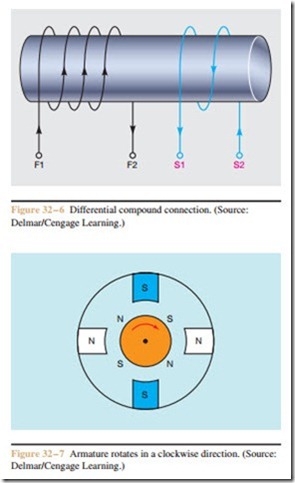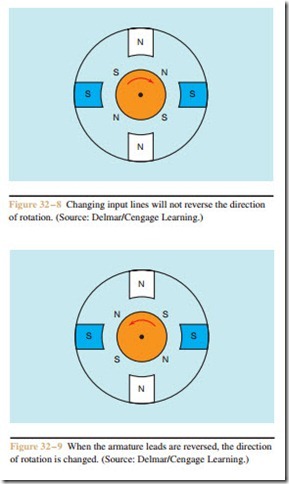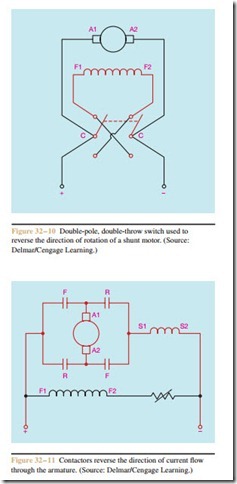Direction of Rotation
The direction of rotation of the armature is determined by the relationship of the polarity of the magnetic field
of the armature to the polarity of the magnetic field of the pole pieces. Figure 32– 7 shows a motor connected in such a manner that the armature will rotate in a clockwise direction due to the attraction and repulsion of magnetic fields. If the input lines to the motor are re- versed, the magnetic polarity of both the pole pieces and the armature will be reversed and the motor will continue to operate in the same direction (Figure 32– 8).
To reverse the direction of rotation of the armature, the magnetic polarity of the armature and the field must be changed in relation to each other. In Figure 32– 9, the armature leads have been changed, but the field leads have not. Notice that the attraction and repulsion of the magnetic fields now cause the armature to turn in a counterclockwise direction.
When the direction of rotation of a series or shunt motor is to be changed, either the field or the armature
leads can be reversed. Many small DC shunt motors are reversed by reversing the connection of the shunt field leads. This is done because the current flow through the shunt field is much lower than the current flow through the armature. This permits a small switch, instead of a large solenoid switch, to be used as a revers- ing switch. Figure 32–10 shows a double-pole, double- throw (DPDT) switch used as a reversing switch. Power is connected to the common terminals of the switch and the stationary terminals are cross connected.
When a compound motor is to be reversed, only the armature leads are changed. If the motor is reversed by changing the shunt field leads, the motor will be changed from a cumulative compound motor to a differential compound motor. If this happens, the motor speed will drop sharply when load is added to the motor.
Figure 32– 11 shows a reversing circuit using magnetic contactors to change the direction of current flow through the armature. Notice that the direction of current flow through the series and shunt fields remains the same whether the F contacts or the R contacts are closed.


